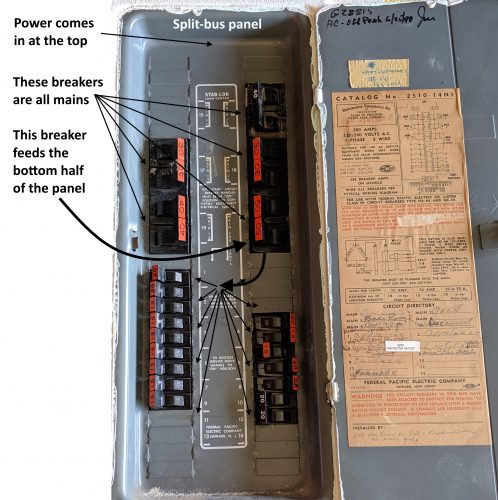History
Split Bus Panels were installed between the 1950’s and the 1970’s. However, they were discontinued by the mid 1980’s as problems continuously arose. This type of panel was designed without a main breaker like modern panels today have. Instead, they have 2-pole breakers installed at the top of the upper bus section. Those breakers are labeled as the service disconnects. The lower bus bar section is fed from a 2-pole circuit breaker in the upper bus bar section. As a result, it requires you to switch off all circuit breakers in the upper bus bar section to be sure power is disconnected to the lower bus bar section. The NEC requires these panels consist of no more than six (6) throws to disconnect the home’s entire electrical system.
Dangers of Split Bus Panels
As more appliances and devices were installed and used in modern homes, the required circuitry began to exceed the capabilities of the split bus panels. The double block main breaks are traded out for individual circuits. This causes overloading which leads to excessive heating of the panel’s internal components. This, of course, can lead to a fire. It also causes the home to have more than 6 throws to disconnect the power in case of emergency. Today, Split Bus Panels would not meet UL safety requirements for this. But there are several other reasons these panels should be replaced with a more modern electrical panel.
Meanwhile, Split Bus Panels that are still around are now anywhere from 40-70 years old. The Consumer Product Safety Commission believes the average life span for a residential circuit breaker is 30-40 years. Any circuit breaker older than this can malfunction but not tripping when it should. That is to say, they should be replaced every few decades.
If your home or soon to be home has a Split Bus Panel, give us a call today. One of our representatives can discuss your concerns with you and/or schedule an appointment for an electrical evaluation. The call is a free consultation, and could help save your home from disaster.
For more information on Split Bus Panels, follow this link.
Disclaimer:
We take great care to provide the most accurate information on this page. However, all content is for informational purposes ONLY and should be considered as General Knowledge or even as entertainment. It should not be relied on, as every case and/or reader is different.
ALWAYS call and check with a qualified electrician before attempting or acting upon anything you read on this site. Changes are always happening within the NEC, standards and regulations, and State, County, and City by-laws.




